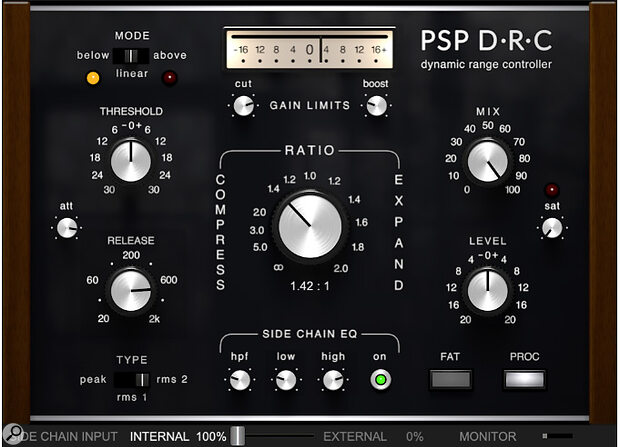It might give off dbx vibes, but this plug‑in offers even more control than the hardware that inspired it.
Although inspired by the hardware dbx 118, PSP’s new DRC plug‑in is not an outright emulation of it. Like the dbx, it’s capable of compression or expansion, and it can work across the entire dynamic range of the input. However, it’s a little unusual in that it also offers the option to process only signals that fall above or below the threshold. It’s also worth noting that, with appropriate settings, two instances could be pushed into service as a complementary compressor‑expander pair. DRC supports all the usual plug‑in formats on Mac and Windows, and authorisation requires an iLok account.
Ups & Downs
Figuring out how DRC works requires a basic understanding of the different ways in which compressors and expanders can be made to work. Most compressors are designed to pull down signals that exceed a certain threshold, but it’s also possible to create an ‘upward compressor’ that works the other way around, increasing the level of signals below the threshold, while leaving those above it unchanged.
PSP’s DRC combines VCA‑style level detection with a choice of three operating modes: Linear, Below or Above. Linear refers to processing across the entire dynamic range, and in this mode processing can be applied to signals falling either side of the threshold. Below processes only signals that fall below the threshold level, while Above processes only signals that exceed it. These distinctions apply to both the compressor and expander settings.
The usual complement of compressor/expander controls is there, with a small Attack knob being joined by larger ones for Release and the processing Threshold. Above the last of these is the three‑way Mode switch, with virtual LEDs to show that the signal is above/below the threshold. To its right, a gain meter’s central zero position corresponds to the threshold, and below this are helpful controls to limit the amount of gain reduction/boost. The largest knob, Ratio, delivers compression when set anti‑clockwise but expansion when clockwise of centre, with compression ratios going up into limiting territory, and the expansion increasing in increments of 0.2 up to 1:2.
Bottom centre of the GUI are side‑chain controls that give you plenty of control over the response: an adjustable high‑pass filter is joined by low and high shelving filters (100Hz and 4kHz), and the strip at the bottom hosts an Internal/External side‑chain mix fader and side‑chain Monitor function. On the right are master wet/dry Mix and output Level controls, while a small Saturation knob adds gentle distortion after the Level control. A Proc button acts as bypass, while the adjacent Fat button selects a higher internal sampling rate, to minimise aliasing artefacts.
If you keep an eye on the gain meter when switching modes, you’ll soon get the hang of what DRC is actually doing.
In Use
The above description might make this plug‑in seem complex, but it’s versatile and effective, and if you keep an eye on the gain meter when switching modes, you’ll soon get the hang of what DRC is actually doing. I found that the expander in Above mode was particularly good at lifting out strong kick and snare beats from a drum loop, while leaving lower‑level elements, such as hi‑hats, intact. But I could also use it as a ‘soft gate’ in Below mode. Compression in Linear mode is effective for levelling vocals and other such dynamic sources, and used like this it doesn’t seem to introduce any obvious side‑effects. Still, the two ‘limit’ controls were really useful in preventing the gain change from becoming excessive. I found DRC useful both for subtle track and mix refinement, and when used more assertively for creative dynamic reshaping, such as altering the perceived balance of sounds in a rhythm loop.
In summary, then, this plug‑in stands out as being different from the average dynamics plug‑in. It covers a variety of mixing tasks where precise control over signal dynamics is the main priority, and it offers a flexible approach towards dynamics processing that rewards experimentation.
Summary
A lovely, versatile dynamics processor, PSP’s new DRC plug‑in breathes fresh life into the dbx 118 concept to deliver something that stands out from the crowd.

